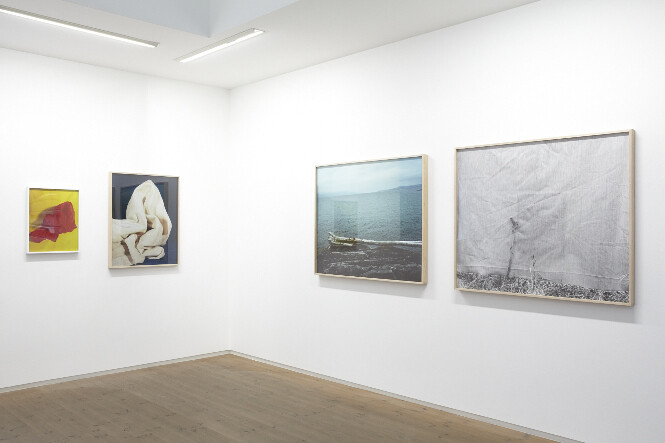To coincide with his second exhibition in Japan, “BC RIPS” at Tokyo’s Taka Ishii Gallery, Sterling Ruby has curated a show of photographs by Los Angeles artists Sarah Conaway and Melanie Schiff. Held at the small Taka Ishii Gallery Modern space in Roppongi district and featuring just five images–one of a fallen tree and another of a plant from Schiff, and three photographs of fabrics variously folded and reposed from Conaway—it’s a difficult show.
Sarah Conaway’s three works are displayed across two different walls of the gallery. Two color images, Red and Yellow Fold (2011) and White and Blue Fold (2014), hang on one wall, while the third work, the black-and-white Religious Experience (2008), hangs on another. Conaway shoots mundane subjects that lack immediately apparent content. In doing so, and like those artists associated with the “Pictures” exhibition of 1977, organized by Douglas Crimp and credited with identifying a then new postmodernist approach to image-making, she explores the instability of meaning in any representation, even a photograph, which, as Roland Barthes famously pointed out, is assumed to be without code.1
Simultaneously deploying the tropes of painting, photography, and sculpture, Conaway’s folded fabrics resist easy categorization. They are, however, consistent with Conaway’s studio-based photographic practice, which primarily consists of still lives of existing and constructed objects that explore the boundaries between photography and sculpture. With their short depths of field and resulting softness, warm tones, and abstract forms set against contrastingly colored backgrounds, Red and Yellow Fold and White and Blue Fold mimic painting. In contrast, Religious Experience situates a similarly folded fabric upon a fabric-covered pedestal in reference to sculpture, closely resembling the early abstract photographic works of James Welling, particularly those from the series “Drapes” (1981–1989), which bears strong similarities to Conaway’s photographic work. Conaway’s images, like Welling’s, catch the viewer in the act of looking and making meaning.
In contrast, the recognizable subjects of Schiff’s images challenge the viewer to identify and extract meaning. Neither the earlier references to partying, music, and youth culture of her work, nor her characteristic use of dramatically warm Californian light are present in these pieces. Natives I (2013) is a black-and-white image showing a ragged plant in a grassy field posed, as in a portrait, against a textured and wrinkled backdrop. The image functions as an allegory for the way the photographer identifies and captures something remarkable in what would otherwise have been overlooked. What that remarkable something is, however, remains unclear. The other photograph on display, Blood Bank (2012), is an attractively cool-colored landscape image that shows a bloodstained, fallen tree on a rocky shore. A bloodstain is, of course, intriguing in a whodunit kind of way, giving the image a narrative quality and connoting, as in a noir film, that something is awry.
Sterling Ruby’s own exhibition at Taka Ishii features large paintings from his “BC” series (2011–), where bleached, Rorschach-like forms evoke Andy Warhol’s Rorschach paintings (1984) and glued-on, striped fabrics, placed centrally and vertically, reference Barnett Newman’s “zips,” first painted in Onement I (1948). Whereas the obscure nature of Conaway’s and Schiff’s work comes off as stingy, the referential nature of Ruby’s exhibition more generously provides a framework by which to understand the works and his own curatorial intentions.
Driven by the erosion of the clear boundaries between the various media they engage, the ambiguousness of Conaway’s images turns the folds she photographs into targets for viewers’ projections, not unlike Rorschach tests. In Schiff’s images, however, we know immediately that we’re looking at a plant or a bloody piece of wood, even if we don’t really know why. Photographic genres, such as portraiture, landscape, and narrative, are evoked in slightly charged, but not, ultimately, productively confounding ways. Schiff’s work straddles multiple histories of photography, but it doesn’t challenge them. In the 1980s the stakes of articulating an anti-modernist position seemed clear. This sort of anti-modernist criticality—what is sometimes pejoratively called “academic theory”—has since fallen out of favor. Regardless, Conaway shares many of the same concerns embraced by that particular moment of art making and criticism. In juxtaposition, Schiff’s work evinces the unfashionable state of academic theory, and—in an unfortunate example of throwing out the babe with the bathwater—of politically urgent criticality in the current gallery world.
Roland Barthes, “The Photographic Message,” in Image Music Text, trans. Stephen Heath. (New York: Hill and Wang, 1977) 17.









